Main Menu

Weapons
Das Gewehr 98
The Gewehr 98 (abbreviated G98, GEW 98 or M98) is a German bolt action Mauser rifle firing cartridges from a 5 round internal clip-loaded magazine that was the German service rifle from 1898 to 1935, when it was replaced by the Karabiner 98k. It was hence the main rifle of the German infantry during World War I. The Gewehr 98 replaced the earlier Gewehr 1888 "Commission" rifle as the German service rifle. The Gewehr 98, and especially its action, also directly influenced the design of many other military rifles of the era such as the M1903 Springfield, the M1917 Enfield and the Arisaka.
Gewehr 98 derived its name from the year it entered service, 1898. The bolt-action design used for the Gewehr 98 was patented by Paul Mauser on 9 September 1895. The Gewehr 98 itself was the latest in a line of Mauser rifles that were introduced in the 1890s.
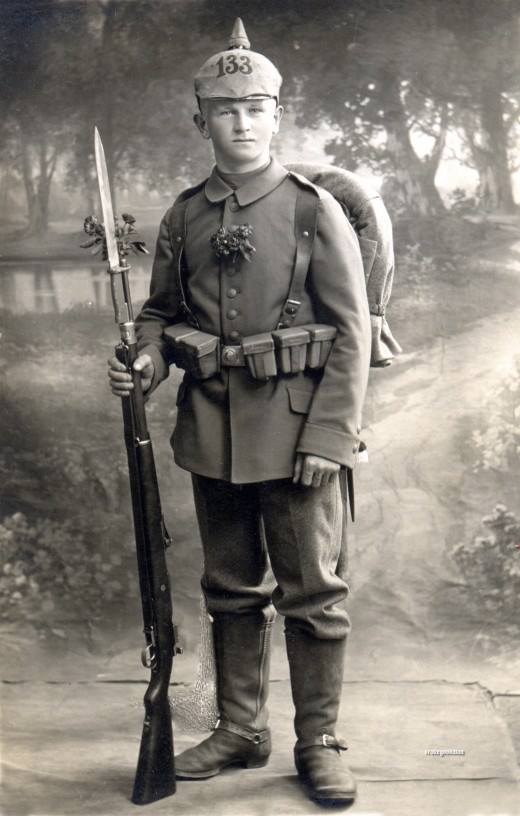
Original photo of a Soldat with the
M.1898 Gewehr.
The German Gewehr-Prüfungskommission (G.P.K.) (Rifle Testing Commission) adopted the Gewehr 98 on 5 April 1898. The action was derived from the experimental Gewehr 96 Rifle. In 1901, the first troop issues of the Gewehr 98 Rifles were made to the East Asian Expeditionary Force, the Navy and three premier Prussian army corps. The Gewehr 98 received its first combat use in the Boxer Rebellion (1898-1901).

The Gewehr 88 "Commission" rifle. This model of rifle continued to see use for many years after the adoption of the Gewehr 98, even through the war. It was converted to use the same ammunition as the Gewehr 98 to simplify supply, but use of this rifle was for training and other non-combat uses to free up the supply of Gewehr 98's for front-line use. This rifle is not authorized for use in JR63.
Use of Gewehr 98s in IR63
IR63 portrays the 2nd Rifle Platoon, 3rd Company, Infantry Regiment Nr. 63. As such, all members of IR63 are Rifleman and are required to own the Mauser Gewehr 98. However, by 1917/18, rifle squads would also have been equipped with two light machine guns, the Maschinengewehr 08/15.
In IR63, all members actually support the light machine guns, helping carry ammo from the bunker to the trenches, but during combat, each gunner will have one designated crewman. Both the MG gunner and crew member will also be equipped with pistols, either the M.1914 Mauser Pocket Pistol or Luger P.08 Parabellum.
M.1914 Mauser Pocket Pistol
German designers from famous Mauser Werke worked on various semi-automatic pistols since about 1893. In the year of 1909 they set to develop a new, relatively simple semiautomatic pistol, chambered for 9x19mm Luger ammunition with reduced load. This weapon was not a great success.
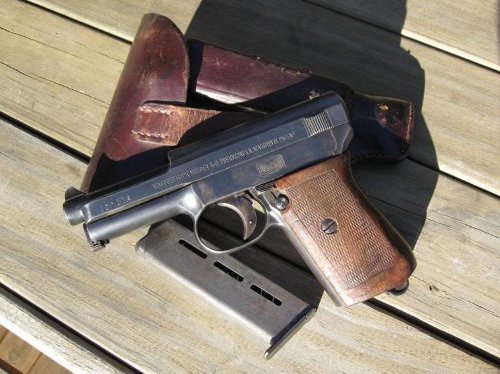
The
M.1914 Pistolen with spare magazine and holder
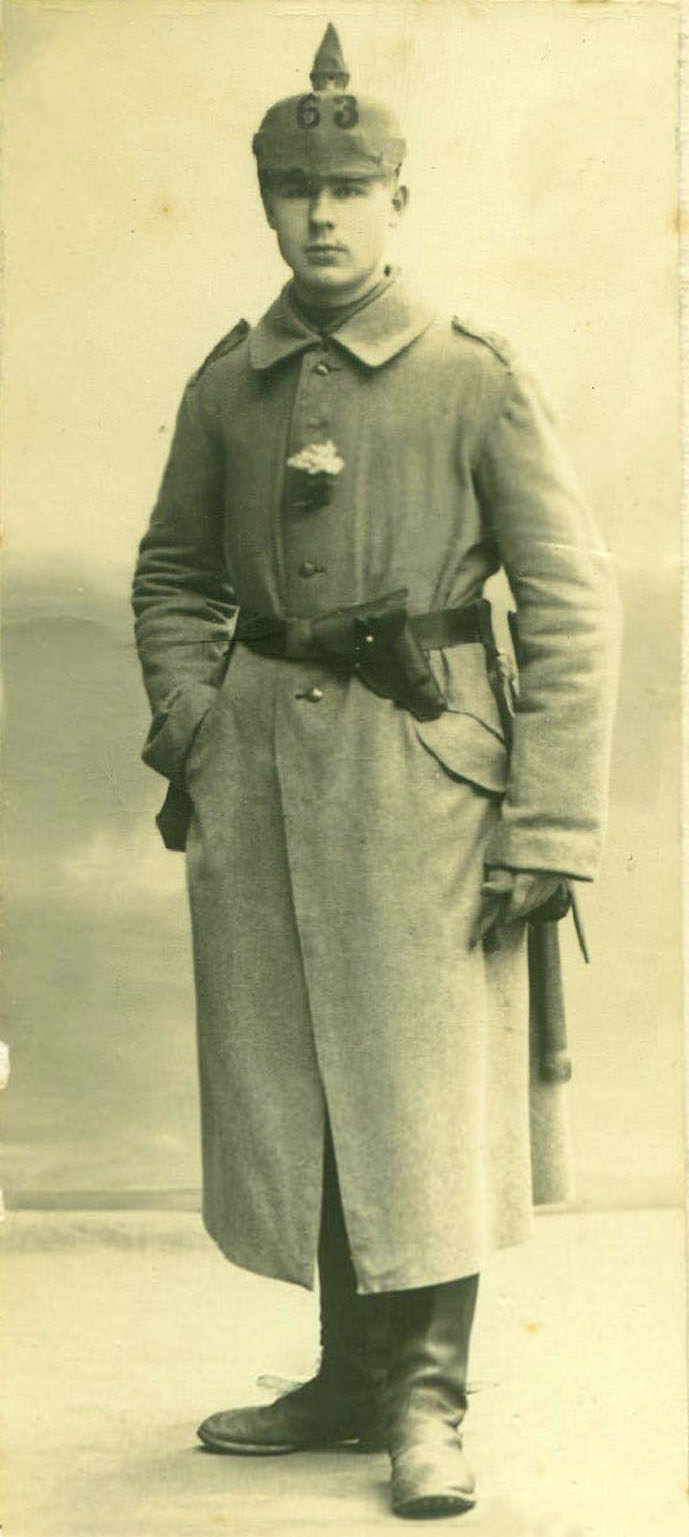
Original photo of an IR63 Soldat with M.1914 Pistolen
In the mean time, it was decided that a new design is more suitable for ammunition, less powerful than a "military" 9mm Luger, so, in the 1910, the basic design was scaled down to relatively new 6.35mm Browning ammunition (known in USA as .25ACP, first introduced in 1906 in Europe and in 1908 in USA). Known as Mauser Model 1910, this became a rather successful pocket pistol. Just before the start of World War One, Mauser turned out a slightly bigger version of the same gun, chambered for another Browning-designed cartridge, the 7.65mm (also known as .32ACP). Limited numbers of these 7.65mm pistols were used by German Army during World War 1.
The Pistole 08 / Luger P08 Parabellum
The Pistole Parabellum 1908 or Parabellum-Pistole (Pistol Parabellum) — popularly known as the Luger — is a toggle-locked recoil-operated semi-automatic pistol. The design was patented by Georg J. Luger in 1898 and produced by German arms manufacturer Deutsche Waffen und Munitionsfabriken (DWM) starting in 1900; it was an evolution of the 1893 Hugo Borchardt designed C-93. The first Parabellum pistol was adopted by the Swiss army in May 1900. In German army service it was succeeded and partly replaced by the Walther P38 in caliber 9×19 mm Parabellum.
The Luger is well known from its use by Germans during World War I and World War II, along with the interwar Weimar Republic and the post war East German Volkspolizei. Although the Luger pistol was first introduced in 7.65×21 mm Parabellum, it is notable for being the pistol for which the 9×19 mm Parabellum (also known as the 9 mm Luger) cartridge was developed.
In 1908 the German Army adopted the Luger to replace the Reichsrevolver in front-line service. The Pistole 08 (or P.08) had a 100 mm barrel and was chambered in 9×19 mm Parabellum. The P.08 was the usual side arm for German Army personnel in both world wars, though it was being replaced by the by the Walther P38 starting in 1938.
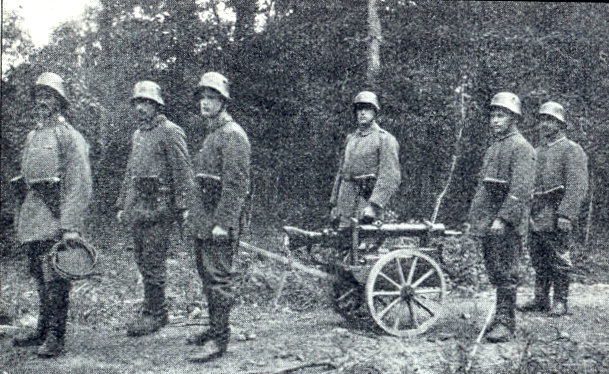
In this fuzzy photo of a machine gun crew, all members are wearing
the
P.08 Luger with the
Maschinengewehr 08/15 on the
purpose-built ammunition wagon
Use of pistols in IR63
Members of IR63 authorized to carry a pistol(machine gunners and crew, and unit CO's if their rank is Sergeant) shall carry a Mauser M.1914 or the standard P.08 Luger pistol (not the P.04 model commonly referred to as the Artillery Luger - a navy weapon). These shall be real M.1914 or P.08's and not cheap blank-fire only weapons. The choice to blank-adapt these pistols is owner's choice, but please note that without blank adaption, these guns will have to be cocked after each shot.
Maschinengewehr 08/15
The Maschinengewehr 08, or MG08,
was the German Army's standard
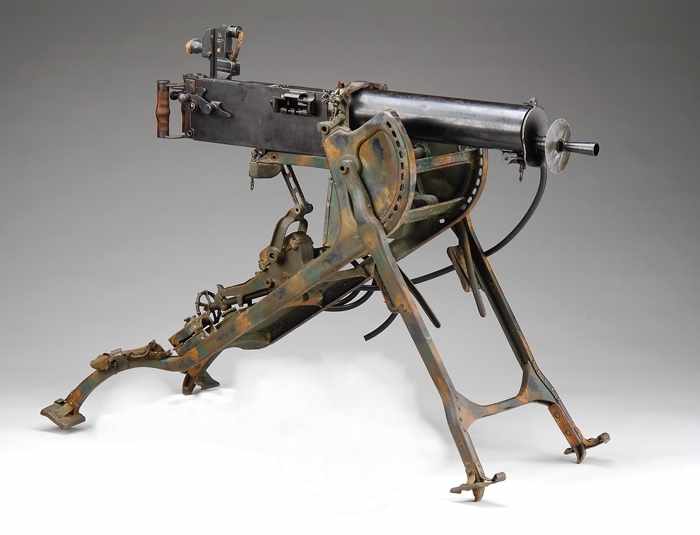 machine gun in World War I and is an adaption of Hiram S. Maxim's original 1884 Maxim
Gun. It could reach a firing rate of up to 400 rounds per minute using 250-round fabric belts
of 7.9mm ammunition. It was water-cooled using a jacket around the barrel that held
approximately one gallon. It operated on the basis of short barrel recoil and a toggle
lock; once cocked and fired the MG08 would continue firing rounds until the trigger
was released (or until all available ammunition was expended). Its practical range was
estimated at some 2,000 meters (2,200 yd) up to an extreme range of 3,600
meters (3,900 yd). The MG08 was mounted on a sled
mount (German: Schlitten) that
was ferried between locations either on carts or else carried above
men's shoulders in the manner of a stretcher.
machine gun in World War I and is an adaption of Hiram S. Maxim's original 1884 Maxim
Gun. It could reach a firing rate of up to 400 rounds per minute using 250-round fabric belts
of 7.9mm ammunition. It was water-cooled using a jacket around the barrel that held
approximately one gallon. It operated on the basis of short barrel recoil and a toggle
lock; once cocked and fired the MG08 would continue firing rounds until the trigger
was released (or until all available ammunition was expended). Its practical range was
estimated at some 2,000 meters (2,200 yd) up to an extreme range of 3,600
meters (3,900 yd). The MG08 was mounted on a sled
mount (German: Schlitten) that
was ferried between locations either on carts or else carried above
men's shoulders in the manner of a stretcher.
Maschinengewehr 08 mit Schlitten
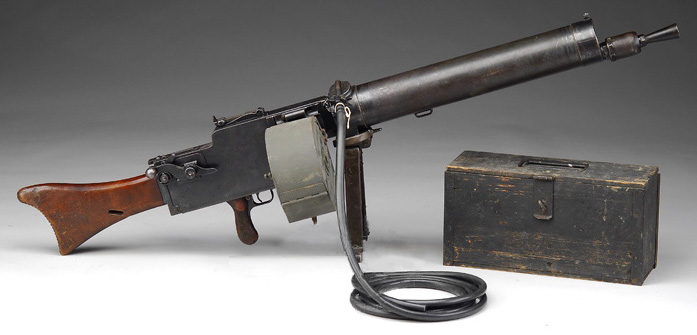 Maschinengewehr 08/15
Maschinengewehr 08/15
Displayed with steam hose and drum, alongside a drum carrier.
Despite the success of the Maxim 08 MG on the battlefield, it became apparent that a lighter, less cumbersome weapon would be a great advantage. The British deployment of their air cooled Lewis LMG was particularly effective, allowing the rapid relocation of defensive MG support in the close confines of the trenches of the Western Front. The French also sought to develop a light automatic weapon (the Chaut Chaut) a magazine fed, air cooled machine rifle which could be operated by a single soldier.
Developed under the direction of Colonel von Merkatz, the new, portable automatic weapon that emerged was christened the MG08/15. This design paradigm, by which the standard heavy machine gun was adapted so as to provide a portable version, was in marked contrast to the path taken by the Allies. The Allied armies adopted a number of light automatic weapons that were not at all adaptations of their heavy types. In doing so they undoubtedly managed to adopt much more efficient designs, but at the cost of overall production efficiency. The German decision to stay with the Maxim design simplified both production and training.
By 1916 it was being fully deployed throughout the German lines. It was instrumental in the disaster of the Somme, at times cutting down advancing British troops in windrows much like they were wheat.
Over 130,000 08/15's were produced during the war, which resulted in one other dubious fact that should be related. It is singularly responsible for more causalities on the battlefield than any other weapon ever deployed, including the Atomic Bomb. It has truly earned the reputation of the Devils Paint Brush.
Use of Maschinengewehr in IR63
Member's of IR63 who invest in the purchase of an MG08/15 will buy the gun, the parts, and their own ammunition at their own expense. These guns will be original, fully functional weapons and they will have all the proper licensing and paperwork. Using illegal Class III weapons places us all in jeopardy and will not be allowed.
